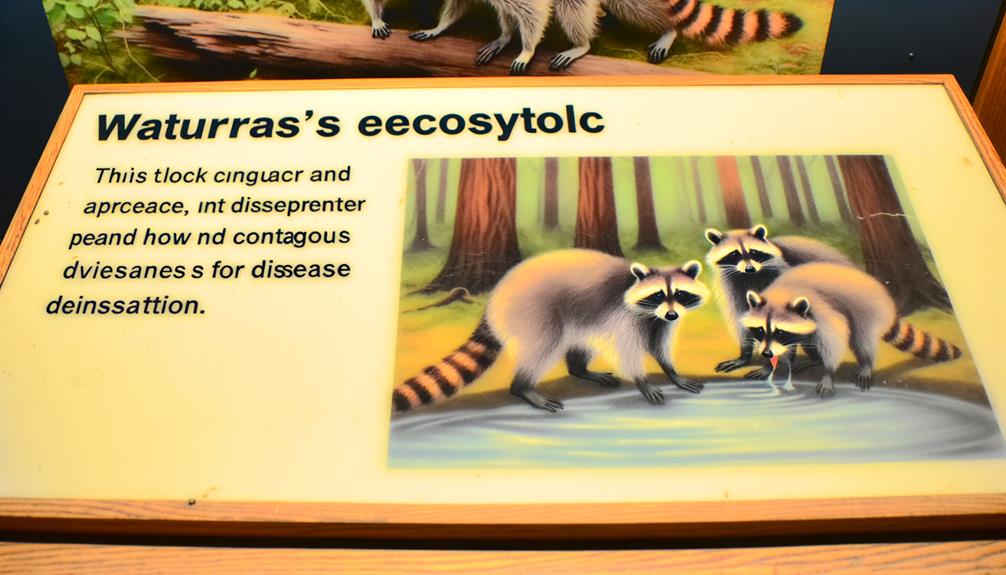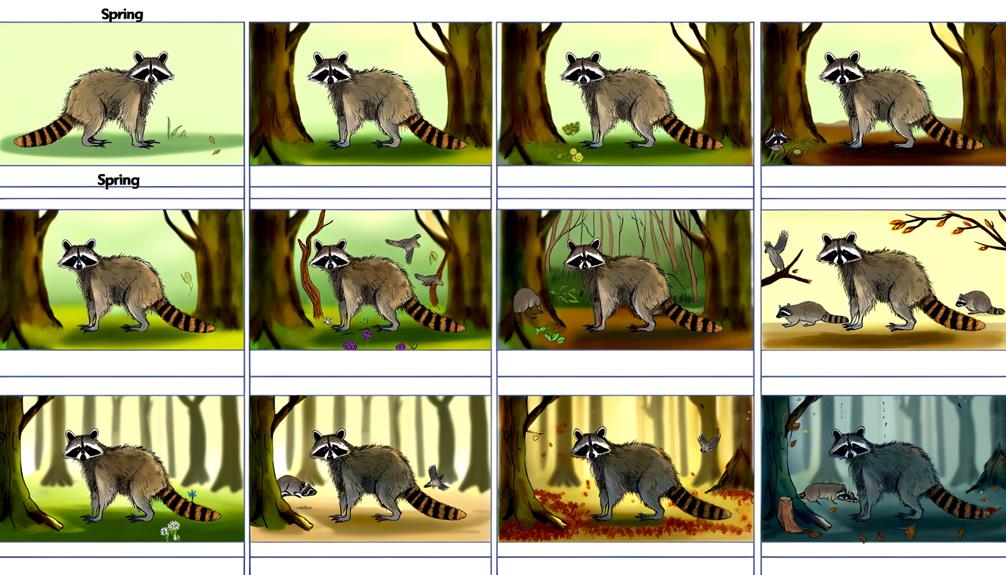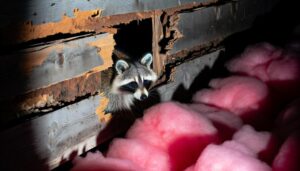Understanding How Long Raccoons Live With Distemper
Raccoons infected with distemper can survive anywhere from a few weeks to several months depending on various factors such as disease stage and overall health. The virus, affecting the respiratory, gastrointestinal, and central nervous systems, initially manifests as mild symptoms before progressing to severe neurological damage and systemic failure in the terminal stage.
Survival is influenced by immediate access to shelter, food availability, and the quality of supportive care received. Monitoring and managing distemper through sanitation and vaccination campaigns are essential to controlling its spread.
Understanding these aspects provides insights into mitigating the impact on wildlife populations.

Key Takeaways
- Raccoons with distemper typically survive for 2-4 weeks after the onset of symptoms.
- The disease progression leads to severe neurological damage, often resulting in death within a month.
- Early supportive care may slightly extend the survival period but doesn't cure the disease.
- Survival time is influenced by the raccoon's overall health and environmental conditions.
- Terminal stage symptoms like systemic failure significantly shorten the raccoon's lifespan.
Understanding Distemper in Raccoons

Distemper in raccoons is a highly contagious viral disease caused by the Canine Distemper Virus (CDV), which affects the respiratory, gastrointestinal, and central nervous systems. The virus is spread through direct contact with bodily fluids or contaminated environments, such as food and water sources.
CDV can infect various wildlife species, including raccoons, making it a significant concern for wildlife health. The virus initially targets the lymphatic tissue before spreading to epithelial and neural tissues, leading to widespread infection. Raccoons are particularly susceptible due to their social behavior and frequent interaction with contaminated environments.
Understanding the transmission dynamics and pathogenesis of CDV in raccoons is essential for developing effective management and control strategies to mitigate the spread of this debilitating disease.
Symptoms of Distemper
A raccoon infected with Canine Distemper Virus (CDV) may exhibit a range of symptoms, which can vary in severity and progression. Observing these symptoms is essential for early detection and understanding the disease's impact on the animal. Common symptoms include:
- Respiratory Issues: Raccoons may display nasal discharge, coughing, and difficulty breathing, indicative of respiratory system involvement.
- Neurological Symptoms: Infected raccoons might suffer from seizures, tremors, and lack of coordination, reflecting central nervous system damage.
- Gastrointestinal Distress: Symptoms such as vomiting, diarrhea, and loss of appetite are common, leading to severe dehydration and weight loss.
- Ocular Manifestations: Conjunctivitis, characterized by red, swollen eyes with discharge, can also occur, impairing vision.
These symptoms collectively highlight the multidimensional impact of CDV on raccoon health.
Transmission Methods

Transmission of distemper in raccoons primarily occurs through direct contact with infected individuals, facilitating the spread of the virus.
Additionally, airborne particles can contribute to transmission, especially in densely populated areas where raccoons are in close proximity.
Contaminated food sources also pose a significant risk, as the virus can persist in the environment and be ingested by raccoons during feeding.
Direct Contact Spread
Raccoons can contract distemper through direct contact with bodily fluids such as saliva, urine, or blood from an infected animal. This transmission method occurs through various interactions in their natural environment.
Key scenarios where direct contact spread is most significant include:
- Grooming: Raccoons often groom each other, which can lead to the transfer of infected saliva.
- Fighting: Aggressive encounters can result in wounds, exposing raccoons to infected blood.
- Shared Food Sources: Communal feeding areas can become contaminated with infected urine or saliva.
- Maternal Care: Infected mothers can transmit the virus to their offspring through close physical contact.
Understanding these transmission routes is vital for implementing effective control measures to minimize the spread of distemper among raccoon populations.
Airborne Particle Transmission
In addition to direct contact, raccoons can also contract distemper through airborne particles, which are expelled when infected animals cough or sneeze. These particles contain the distemper virus and can remain suspended in the air, posing a risk to nearby raccoons.
Inhalation of these contaminated particles allows the virus to enter the respiratory system of healthy individuals. The efficiency of this transmission method is influenced by environmental factors such as humidity and temperature, which affect particle stability and dispersal.
Studies indicate that closed or densely populated environments facilitate the spread of the virus via airborne particles. Understanding this transmission route is foundational for implementing effective disease management and control strategies, particularly in urban areas where raccoons are common.
Contaminated Food Sources
Consumption of contaminated food sources represents another significant transmission method for distemper in raccoons, as the virus can survive on various surfaces and be ingested during foraging activities. Raccoons are opportunistic feeders, increasing their exposure risk when scavenging in both urban and rural environments.
Contaminated food sources can include:
- Garbage: Improperly disposed of food waste can harbor the virus, posing a risk when raccoons scavenge.
- Pet Food: Outdoor bowls left unattended can become contaminated by infected animals.
- Carcasses: Consuming infected deceased animals can facilitate virus transmission.
- Agricultural Products: Crops and stored produce contaminated by infected wildlife can serve as transmission vectors.
Understanding these transmission pathways is essential for mitigating the spread of distemper among raccoon populations.
Incubation Period
Following exposure to the distemper virus, the incubation period in raccoons typically spans from one to two weeks before clinical symptoms manifest.
During this period, the virus actively replicates within the host, targeting the lymphatic system initially. This phase is critical as the host remains asymptomatic and can unknowingly spread the virus to other raccoons and susceptible species.
The variability in the incubation period can be attributed to factors such as the viral load upon exposure, the immune competence of the raccoon, and environmental stressors.
Understanding the incubation period is essential for wildlife management and disease control, as it underscores the importance of timely detection and intervention to mitigate the spread of this highly contagious pathogen.
Stages of Disease

Once the incubation period concludes, the progression of distemper in raccoons can be delineated into distinct stages, each characterized by specific clinical manifestations and pathophysiological changes.
- Initial Stage: Mild symptoms such as fever, nasal discharge, and ocular discharge. Raccoons may exhibit lethargy and loss of appetite.
- Gastrointestinal Stage: Symptoms escalate to vomiting, diarrhea, and dehydration, leading to significant weight loss.
- Neurological Stage: Severe manifestations including seizures, tremors, and uncoordinated movements. Behavioral changes such as aggression or confusion are common.
- Terminal Stage: Advanced neurological damage and systemic failure. Raccoons in this stage are often unable to eat, drink, or move, leading to death if untreated.
Understanding these stages is critical for timely diagnosis and intervention.
Factors Affecting Lifespan
The lifespan of a raccoon infected with distemper is influenced by several critical factors.
These include the severity of the infection, access to shelter, and availability of food.
Severe infections can rapidly debilitate the animal, while adequate shelter can provide necessary protection from environmental stressors.
Additionally, access to a reliable food source is essential for maintaining the raccoon's energy levels and overall health.
Severity of Infection
Factors such as the viral load, age, overall health, and immune response of the raccoon greatly influence the severity of the distemper infection and consequently its lifespan.
The progression and impact of the disease can vary significantly based on several key factors:
- Viral Load: Higher viral loads generally correlate with more severe symptoms and a quicker decline in health.
- Age: Younger and older raccoons tend to have weaker immune systems, making them more susceptible to severe infections.
- Overall Health: Pre-existing conditions can exacerbate the severity of the infection, shortening the raccoon's lifespan.
- Immune Response: A robust immune system can mitigate the severity of the disease, potentially prolonging the raccoon's life.
Understanding these factors provides insight into the variable outcomes of distemper infections in raccoons.
Access to Shelter
Access to shelter plays a significant role in determining the lifespan of a raccoon infected with distemper, as it directly influences their exposure to harsh weather conditions and potential predators. Sheltered raccoons can avoid extreme temperatures, which is essential since the disease often compromises their thermoregulation abilities.
Additionally, shelter minimizes encounters with predators, as distemper weakens raccoons, making them more vulnerable to attacks. Structures such as burrows, hollow trees, and abandoned buildings provide these essential refuges. Observational studies indicate that raccoons with consistent access to such shelters exhibit a relatively prolonged survival rate compared to those without.
Hence, the availability and quality of shelter are pivotal factors influencing the longevity of raccoons afflicted by distemper.
Availability of Food
Adequate availability of food greatly impacts the survival duration of raccoons suffering from distemper. Nutrient intake is critical for maintaining energy levels and supporting immune function in these afflicted animals.
Factors that influence food availability include:
- Seasonal variations: Food sources fluctuate with seasons, affecting the ability of raccoons to find sufficient sustenance.
- Urban vs. rural environments: Urban areas often offer more consistent food sources through human refuse, whereas rural areas might have more natural but variable resources.
- Competition: The presence of other wildlife can reduce the food available to raccoons, exacerbating their struggle.
- Human intervention: Efforts by humans to feed or rehabilitate sick raccoons can significantly enhance their chances of survival.
These factors collectively determine how long a raccoon with distemper can sustain itself.
Role of Overall Health

An individual raccoon's overall health plays a crucial role in determining its survival duration after contracting distemper. Factors such as age, nutritional status, and pre-existing health conditions greatly influence disease progression.
Younger raccoons and those in excellent health, with no underlying illnesses, generally possess stronger immune responses, potentially prolonging survival. Conversely, raccoons suffering from malnutrition or chronic ailments are typically more vulnerable, experiencing faster disease advancement.
Observations indicate that raccoons with robust health can occasionally withstand the acute phase longer, albeit still facing a high mortality risk. The health status prior to infection can be a key determinant in the trajectory of distemper, highlighting the variability in survival outcomes among infected raccoons.
Importance of Supportive Care
Supportive care is vital for raccoons suffering from distemper. The focus is on hydration and nutrition to sustain their weakened state.
Effective symptom management can alleviate discomfort and prevent secondary infections. Stress reduction techniques help in stabilizing their overall condition.
These interventions are necessary in extending the lifespan and improving the quality of life for affected raccoons.
Hydration and Nutrition
Ensuring proper hydration and nutrition plays a crucial role in the supportive care of raccoons afflicted with distemper, aiding in their overall recovery and immune system function. Adequate hydration prevents dehydration, which can worsen symptoms and complicate the disease process. Nutritional support guarantees that the raccoon receives essential vitamins and minerals necessary for immune response and tissue repair.
Key components of supportive care include:
- Fluid Replacement: Administering fluids orally or intravenously to maintain hydration levels.
- Nutrient-Dense Diet: Providing high-quality food rich in proteins, fats, and vitamins.
- Electrolyte Balance: Using electrolyte solutions to correct imbalances caused by vomiting and diarrhea.
- Monitoring Intake: Regularly tracking food and water consumption to adjust care as needed.
Such interventions are crucial for improving the prognosis of raccoons with distemper.
Symptom Management
Proper symptom management is paramount in the care of raccoons with distemper, as it directly impacts their comfort and chances of recovery. Vital aspects of supportive care include maintaining hydration, administering antipyretics for fever, and providing medications to alleviate respiratory symptoms.
Monitoring neurological signs such as tremors and seizures is also essential, as these can indicate disease progression. Ensuring a clean, stress-free environment helps mitigate secondary infections and supports the immune system.
Nutritional support, tailored to meet the specific needs of an affected raccoon, plays an essential role in maintaining energy levels and overall health. By meticulously addressing these symptoms, caregivers can greatly enhance the quality of life and potential recovery outcomes for raccoons suffering from distemper.
Stress Reduction
Reducing stress is essential in the supportive care of raccoons with distemper, as it can greatly influence their immune response and overall recovery trajectory. Stress can exacerbate symptoms, weaken the immune system, and prolong the disease course.
Effective stress reduction strategies include:
- Environmental Enrichment: Providing a quiet, comfortable space with minimal disturbances can help reduce anxiety.
- Gentle Handling: Limiting handling and ensuring it is done gently can prevent additional stress.
- Consistent Routine: Maintaining a consistent feeding and care schedule can provide a sense of security.
- Social Support: If the raccoon is social, allowing interaction with other raccoons can be beneficial but should be monitored to prevent aggression.
Implementing these strategies can promote a more favorable outcome in raccoons suffering from distemper.
Impact on Wildlife Populations

The prevalence of distemper in raccoon populations greatly disrupts local ecosystems by reducing their numbers and altering predator-prey dynamics. Distemper, a highly contagious viral disease, leads to significant mortality rates among raccoons, thereby diminishing their role as both predators and prey. This reduction can lead to overpopulation of small mammals and insects, which are typically controlled by raccoon predation.
Additionally, the decline in raccoon numbers impacts scavenging roles, potentially increasing organic waste accumulation. This disease also indirectly affects higher trophic levels, as predators that rely on raccoons for food must adapt to the reduced availability, potentially shifting their hunting patterns. The cascading effects illustrate the broader ecological ramifications of distemper outbreaks in raccoon populations.
Managing Infected Raccoons
Effective management of raccoons infected with distemper requires implementing thorough disease control measures and monitoring protocols. This multifaceted approach is essential to mitigate the spread of the virus and safeguard both wildlife and human populations.
Key strategies include:
Identification and Isolation: Accurately identifying infected raccoons and isolating them from healthy populations to prevent further transmission.
Vaccination Programs: Implementing vaccination campaigns for at-risk raccoon populations to build herd immunity.
Public Education: Educating the public about recognizing symptoms and reporting sick animals to local wildlife authorities.
Sanitation and Habitat Management: Maintaining clean environments and reducing access to food sources that attract raccoons, thereby lowering interaction rates.
These measures, when applied systematically, can effectively control the prevalence of distemper in raccoon populations.
Conclusion
To sum up, distemper in raccoons manifests through a harrowing sequence of symptoms, greatly impairing their survival. Transmission occurs rapidly, and the incubation period varies, complicating management efforts.
The disease progresses through distinct stages, with the overall health of the raccoon playing a pivotal role in its outcome. Supportive care is paramount but often insufficient.
The impact on wildlife populations is catastrophic, necessitating vigilant management of infected raccoons to mitigate the disease's spread and preserve ecological balance.






